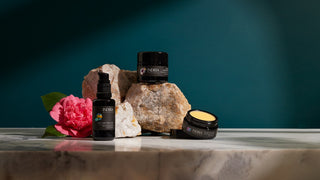Ok, I'm just going to come straight out of the gate and say it: choosing the correct products and managing your skin effectively can be extremely confusing! And this is what I do for a living!
Strap yourself in as today is a bit of a long one. But awfully rewarding so it’ll be worth it, I promise! (Incidentally, a friend recently commented that most of us now have the attention span of a young, fidgety child, so hopefully I don’t lose you all before the end of this post…!)
Let me start by asking whether you know what your skin type is?
When I ask this question, it usually draws a blank stare.
‘Sure’ I hear. Silence. Then a confused look. ‘Actually, what skin type do you think I would have then?’ 🤪
Thankfully, it’s reasonably straight forward to determine your skin type, so here goes!
Common skin types
Generally speaking, there are four common skin types, including:
- Dry: skin prone to rough patches and flaking that often feels tight.
- Oily: characterised by large pores and visible oil on the skin.
- Combination: zones of the skin that behave differently, such as a combination of an oily t-zone and dry cheeks.
- Normal: this skin is reliably clear without dryness or oily patches.
What’s interesting and not widely understood is that you are actually born with a skin type that generally won’t be changing anytime soon - much like that bountiful supply of mint in my garden that has taken root; no matter what I do to clear it, it’s here to stay!
I will caption this by stating that as we age our natural oil levels do slow down and thus it is quite normal for most to experience drier skin over time. Thank-you Mother Nature!
How to determine your skin type
Back to your skin!
In simple terms your skin type describes how much sebum your pores produce and the amount of lipids that sit in your stratum corneum - the topmost layer of your skin. Although there are a number of methods dermatologists generally recommend to classify skin type, the simplest way is to loosely assess the amount of oil you naturally produce, and here’s an easy and effective way to do it:
- Wash your skin first thing in the morning and don’t place any products on it. No, not even one - no sneaky, sneaky allowed!
- Somewhere around lunch time, take a piece of blotting paper and gently press it to different areas of your face.
- If the paper sticks on areas tested, you’re most likely oily; conversely if there’s absolutely no oil, well, you’re skin type is pretty much guaranteed to be dry!
- And if you have oily patches on some areas of your face such as your t-zone, that suggests you have combination skin. Whilst if you have a very minor sheen all over, you would be one of the very lucky few that has normal skin.
Kind of that straight-forward really.
In saying that, there are a number of factors that can change the amount of oil your skin produces including stress, diet, hormones, and medication, which can make things a little more complicated when diagnosing. So go with where your skin is at this very moment if that is your 'normal' - if stress is the norm or you are on regular medication.
Sooooo, I don’t want to confuse the situation ‘n' all, now that you have your skin type sorted, but there is also another aspect to skin classification that you should be aware of called skin condition.
What’s skin condition then?
Skin condition basically describes a specific problem your skin might be experiencing as a result of environmental factors. And it’s very likely you may be experiencing one or more skin condition combined - yeeehah!
The most common skin conditions include:
- Hyperpigmentation: areas of skin that have more pigment than the skin’s usual colour.
- Dehydration: the top layer of skin lacks water inhibiting normal function and leading to a dull complexion – see our recent blog piece explaining in more detail this skin condition.
- Aging: this condition commonly develops as we age from the build-up of environmental damage, showing as fine lines, sun spots or sagging skin.
- Acne: clogged pores that are usually accompanied by both inflamed skin and a combination of white heads, black heads or even deep cysts.
- Sensitive: when the top layers of the skin are compromised or weakened usually by environmental factors, allowing irritants to penetrate the deeper layers of skin. It usually plays out as red, sore or skin that looks and feels generally uncomfortable.
I'm sure it will come as a relief to learn that skin conditions can be managed through an effective skin care routine; cue cheering from the peanut gallery please…..
‘So, what does all of this mean (goodness me), and how do I manage my skin for optimal health?’ I hear you ask!
Here at Indira Organics, we have designed our skincare first and foremost so that all of our products are suitable for sensitive skin, primarily based on the premise that our products are chemical free and therefore irritant reduced. In saying that some people do find essential oils irritating, which is why you should always patch test any new products you intend to add to your skincare routine.
It’s worth noting that at the heart of all of the Indira products is Aloe Vera, which is extremely soothing and repairing for the skin. Tick.
And, that our products contain organic, nourishing oils and butters to restore and calm the skin. Double tick.
So how do I choose what Indira Organics products will suit my skin?
We understand choosing the correct range of products can be quite tricky to say the least, so we have designed a unique system that is relatively simple to navigate and aims to deliver super-effective results.
Our ranges have been designed to treat the most common skin conditions and skin types, where conditions and types are generally linked as a standard rule. So for example:
- Oily skin typically suffers from acne
- Normal skin typically experiences dehydration or pigmentation
- Dry (or mature skin that has slowed natural sebum production) from hyperpigmentation
- Combination skin most frequently suffers from mild congestion
It's important to note that no two people have identical skin, and that our ranges are flexible so you can make easy changes to suit your needs if required. The environment, physical and emotional factors all come into play in influencing skin health, and need to be considered when making your selection.
Here's a quick run through of the Indira ranges and what works best!
Pigmentation Range
Our Pigmentation Range is designed to be rich in lipid levels to help address dry skin (that is pigmented) or skin that may need additional oil levels such as in the winter time when most people notice their skin becoming drier from the colder weather when our pores tighten restricting sebum release.
The serum in this range - the Pigmentation Serum - contains active ingredients proven to fade this appearance of pigmentation by 28% in 12 weeks, noting that as we age and our skin gets more dry, pigmentation generally becomes more problematic for most of us.
Our Pigmentation Range is recommended for those with dry or normal skin.
Hydration Range
Our Hydration Range is formulated with medium levels of lipids and is suitable for combination and normal skin types. The oils used in this range are designed to be replenishing without blocking the pores.
The serum in this range - the Hydration Serum - addresses dehydration via the delivery of actives that are proven to increase skin hydration by up to 128% in 30 days, noting that Winter can often also bring on more dehydration than normal.
Our Hydration Range is recommended for those with combination or normal skin types that regularly experience dehydration.
Congestion Range
And our Congestion Range contains the lowest lipid levels (all low on the comedogenic scale) that won’t clog the pores for those with oily skin types.
Our serum in this range – the Acne Serum – incorporates powerful actives proven to reduce sebum production by 56% in 8 weeks, with other ingredients tasked to gently exfoliate and kill skin bacteria.
Our Congestion Range is recommended for those with acne prone or combination skin types that may suffer the occasional or more active breakouts.
For those that don't fit the norm
“So what if I have combination skin with pigmentation and the occasional breakout? What range then?
Glad you asked!
Well firstly, let me just say you are in good company, as dear reader, this is my predicament!
There’s absolutely no harm in mixing and matching products from different ranges, so, in the case of combination skin that has pigmentation, your best bet would be to start with the congestion range and then either a. try layering in the acne serum alongside the pigmentation serum, or b. try swapping the pigmentation serum for the acne serum, or c. alternate between the pigmentation serum and acne serum depending upon how your skin feels on any one day - which incidentally is my routine and it works an absolute treat!
Same goes if you have dry skin that has both pigmentation and congestion – start with the pigmentation range and either layer the to serums or try swapping the acne serum for the pigmentation serum as you feel you need them on any given day.
Try before you buy
Finally, and perhaps most importantly, we recognise the value in testing before you buy to help you to determine what products work best for you, which is why we offer two complimentary ranges to sample when starting your Indira journey.
This helps you hone in on what feels right for your skin and works, and also saves you wasting your time and money on products you may not. Plus it saves the environment, as you won't be purchasing products that just sit untouched on your shelf.
So........hopefully I still have your attention!
Let us know whether this all made sense for you, or if you have any questions! If you have no more questions, let’s get started on your Indira Organics journey baby!



